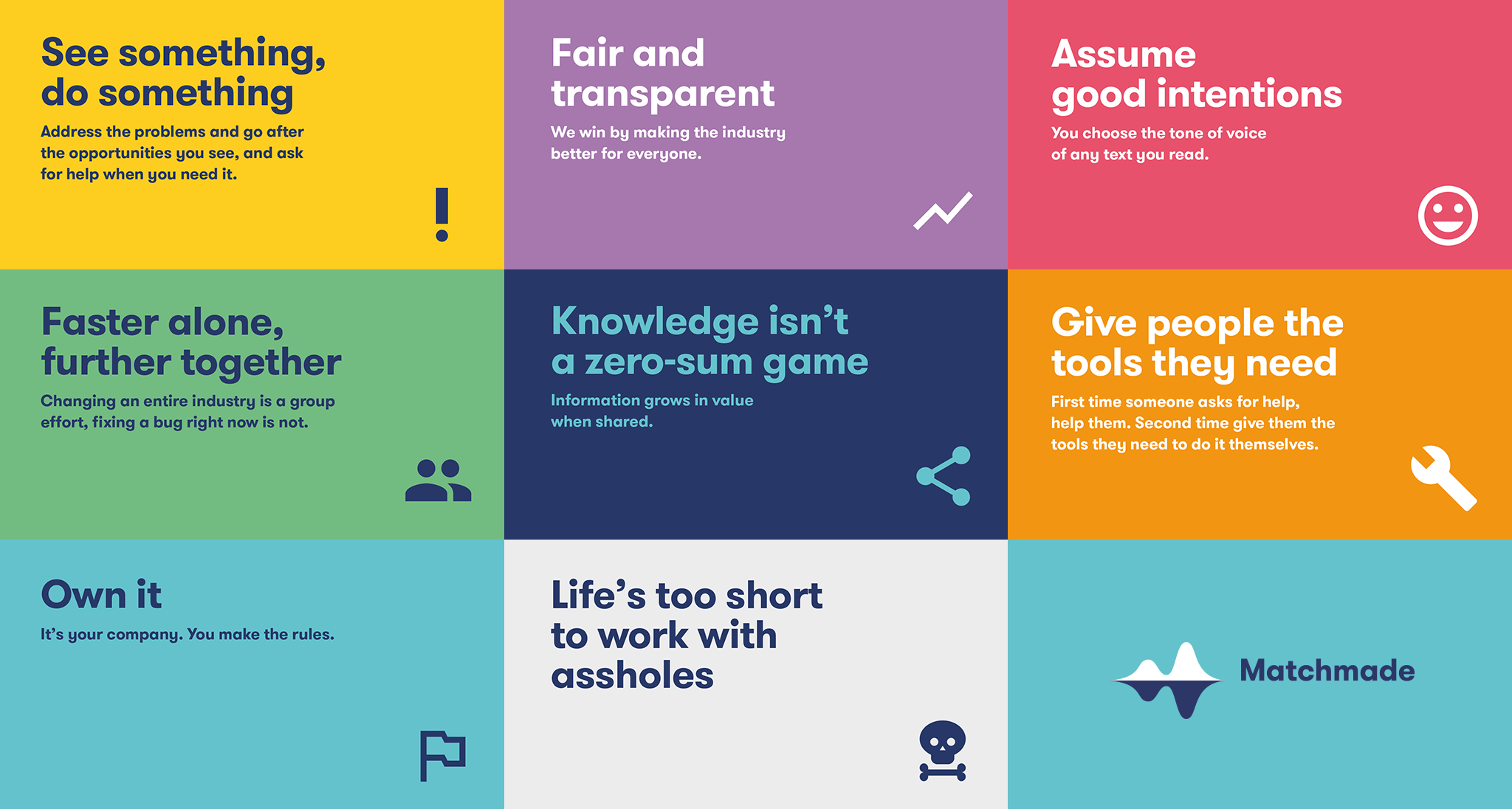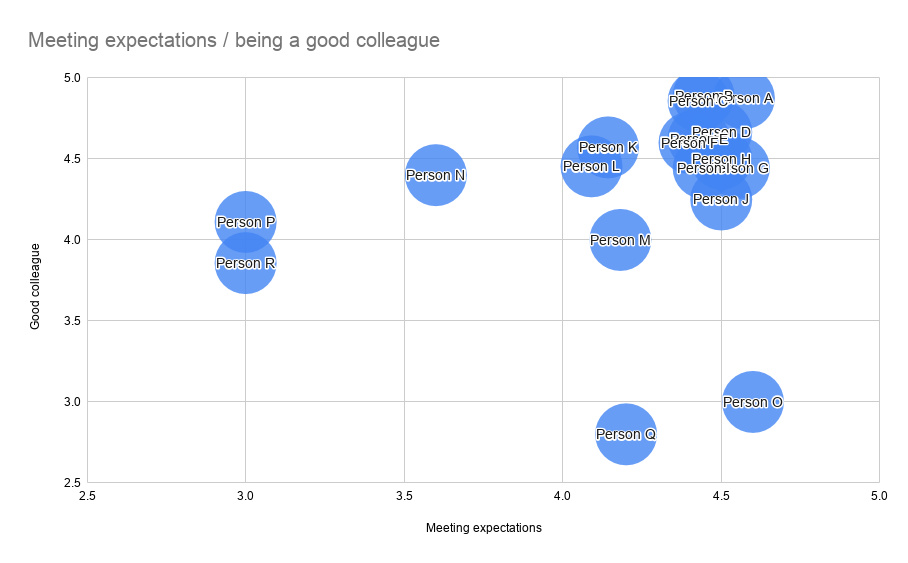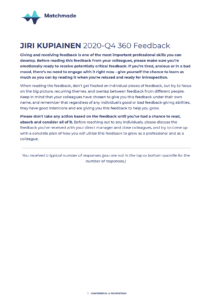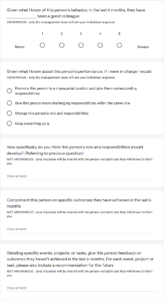360 feedback in startups is often misunderstood and divides opinions. We’ve been iterating on our approach for two years now, so in the name of openness we decided to share what we’ve learned & what our process looks like today (as well as the files we use to run the process.)
What is 360 feedback?
360 feedback can be thought of as an alternative to traditional performance reviews (which we’re not fans of.) The idea is that instead of just their manager, everyone interacting with a specific person can give them feedback.
We take this approach seriously – at Matchmade, everyone in the company can give feedback to anyone else, and we’re thinking of ways to expand this process to stakeholders and customers as well.
Why 360 feedback matters
Companies are made of people, and therefore personal growth of individuals results in the entire company improving. 360 feedback is also a great way to build cohesion and make the company’s culture and values more tangible.
Access to feedback also differs based on your role and position within the company, and real team-wide 360 feedback democratizes access to feedback. As the CEO, I find the 360 feedback process instrumental to my personal growth, since people might not feel comfortable giving direct, critical feedback to me otherwise.

360 feedback vs 360 reviews
Feedback helps you grow, reviews tell you how you’re doing. We combine both into the same process – our 360 feedback form includes both quantitative and qualitative questions, and the questions are worded to encourage focusing on both specific outcomes and events, as well as providing concrete, actionable suggestions.
Anonymous or not?
We’ve gone back and forth on how anonymous the feedback and reviews should be.
100% anonymous had some pros:
- Everyone feels comfortable giving feedback to everyone
- People processing the feedback get the same quality of feedback as everyone else
But the cons were bigger:
- Instead of focusing on helping people grow, it would easily become a way of venting frustrations
- “Review-bombing”, where someone leaves an extremely poor review without any feedback on how the person in question can improve
We’ve settled on a semi-anonymous process:
- Your name is recorded when you fill the form, but only the people processing the feedback can see it
- Reviews are anonymous (but the people processing the form can spot review bombing)
- Feedback is not anonymous – the person receiving the feedback will know it’s coming from you
Having people give feedback under their own name has dramatically improved the quality and actionability of said feedback. Reviews are also less frustration-driven, since people feel they have to justify very poor or very good reviews with feedback.
The downsides of this are that people processing the feedback can receive overly rosy reviews, and that some things might be left unsaid in cases of serious interpersonal issues – you need to provide alternative channels to cover these cases.
Our 360 feedback process
We don’t currently have an in-house people operations person, and the feedback process is run by the management team. Once a quarter, we:
- Prepare the Google Forms surveys for each individual
- Share the links to every individual’s feedback form on Twist and Slack
- Remind people regularly to give feedback to help their colleagues grow
- After the two-week feedback period has ended, we close the forms
- We then collate all the data into a master sheet
- Create individual reports
- Share these with each team member
- Make sure each individual discusses their feedback with at least their manager and close colleagues
- Encourage people to come up with personal goals and development plans
- …and even share them publicly on Twist (for the brave)
Doing it mid-quarter meshes well with our OKR process (the beginning and the end of the quarter can be busy), and a quarterly cycle feels like a good compromise between timeliness and time spent.
The questions in our feedback form
Based on my understanding of this person’s role, these are the outcomes I expect them to achieve
This question acts as a qualifier and a gatekeeper. If people can’t come up with a clear answer to this one, they’re unlikely to proceed with feedback.
Given what I know about this person’s performance, in the last X months, they have [1: never – 5: always] met my expectations
Review question. How is this person performing at their job?
Given what I know of this person’s behavior, in the last X months, they have [1: never – 5: always] been a good colleague
Review question. How are they to work with?
Given what I know about this person’s performance, if I were in charge I would
Review question. Helps with career planning. Choose one of:
- Promote this person to a managerial position and give them corresponding responsibilities
- Give this person more challenging responsibilities within the same role
- Change this person’s role and responsibilities
- Keep everything as is
How specifically do you think this person’s role and responsibilities should develop? (Referring to previous question)
Not anonymous. Helps the person understand what opportunities others see for them.
Compliment this person on specific outcomes they have achieved in the last X months
Not anonymous. People often struggle to recognize their own successes, and in a fast-paced environment it’s easy to focus on what needs fixing at the expense of ignoring progress made and things achieved.
Detailing specific events, projects, or tasks, give this person feedback on outcomes they haven’t achieved in the last X months. For each event, project or task, please also include a recommendation for the future
Not anonymous. Note the prompt for specificity and concrete recommendations.
Tell this person how they can be a better colleague to work with, by giving them specific action points they should execute on within the next X months
Not anonymous. We stopped prompting for specific events for this one, because generally the feedback was always related to behavioral patterns instead of specific instances. But note the prompt for specific action points.
Compliment this person on specific ways they have been a good colleague in the last X months
Not anonymous. Encouraging good behavior is equally important, and it’s good to finish on a positive note!
Analysis and reports
We conduct analysis on two different levels: there’s company-wide analysis, focusing on the quantitative aspect, and then there’s the individual level, which focuses on feedback and personal growth.

Company-level analysis
Collating all the responses into one file allows us to have a birds-eye view of all the people in the company. Plotting people’s reviews on a 2D grid where the X-axis is their average score for performance and the Y-axis their average score for being a good colleague makes it easier to spot outliers. This is done to help management understand who are especially ready to grow into a bigger role, and who needs the most support. We usually end up with four distinct clusters:
- “Going well”, clustered around the top right corner (this is always the biggest group)
- “Struggling to produce results” in the top left corner
- “Behaving badly” in the bottom right corner
- And sometimes “at risk” in the bottom left corner
Good feedback has always helped people in clusters 2 and 3 move towards “going well”, whereas people in the bottom left to corner usually end up leaving the company eventually. In these cases it’s good to have a candid discussion about the feedback they received and their feelings about it promptly to see if the situation can and should be salvaged.

 Individual reports
Individual reports
We don’t share exact review scores with anyone, because sharing them has resulted in people focusing on their “rank” instead of how to make the most out of the feedback they received. However, we do note if a person was in the top or bottom quartile for a specific question, since we find this allows them to better understand what they should be focusing on.
We compile the individual reports manually by copypasting responses into the report template. Coming from a company that loves automating things, that sounds insane. However, it has the clear benefit of forcing management to at least skim through the feedback given to each individual, making it easier to spot things that should be addressed.
Delivering the 360 feedback
The reports are shared with each individual in the company simultaneously. For any outliers, we let their manager know beforehand that there are specific concerns they should discuss with this person, but we don’t share the exact feedback with the manager.
People then schedule feedback review sessions with their managers and their close colleagues – for example, the management team does a session together where we review and discuss the feedback each one of us got, and work together to help each other understand how to make the most of it. The management team makes little personal SWOT analyses and shares these on Twist, but different teams and different individuals within the company deal with feedback differently.
Our 360 feedback templates
You can freely copy and adapt our 360 feedback templates for your own organization. There’s no warranty or support, and this permission is strictly limited to the documents provided within the linked folder. We reserve the right to stop sharing these documents at any given moment for any reason.
You can find the Google Docs / Sheets / Forms templates we use in this public Google Drive folder. Direct links:





